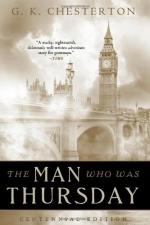|
This section contains 2,480 words (approx. 9 pages at 300 words per page) |

|
SOURCE: "Politics and Perspective in The Man Who Was Thursday," in The Chesterton Review, Vol. 7, No. 4, November, 1981, pp. 329-36.
Leigh is an American educator and critic. In the following essay, he analyzes Chesterton's use of allegory in The Man Who Was Thursday.
The rediscovery of Chesterton's The Man Who Was Thursday by the critics (and even by Time, April 7, 1975) has illuminated the complexity of the allegorical nightmare which even G.K.C. admitted was overloaded with meaning. Although most critics—e.g., Barker, Clipper, Wills, Youngberg—call Thursday Chesterton's best novel, several critics find serious flaws of incoherence. In particular, Ian Boyd finds the novel's two allegories—philosophical and political—"never completely integrated into a coherent whole" [The Novels of G. K Chesterton: A Study in Art and Propaganda, 1975].
In this article, I will contend that Thursday can be read as a coherent pattern blending three main allegories...
|
This section contains 2,480 words (approx. 9 pages at 300 words per page) |

|


